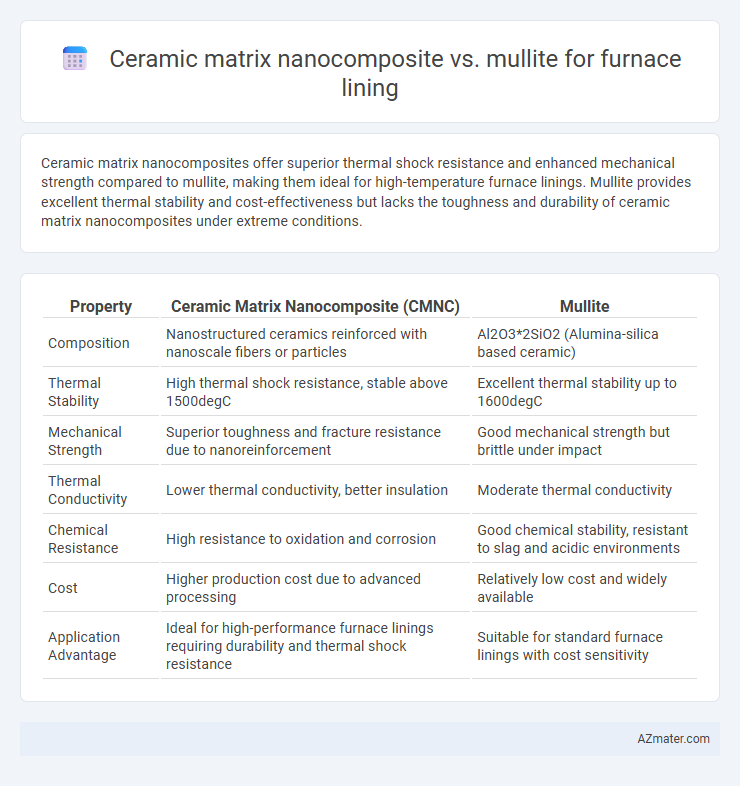Ceramic matrix nanocomposites offer superior thermal shock resistance and enhanced mechanical strength compared to mullite, making them ideal for high-temperature furnace linings. Mullite provides excellent thermal stability and cost-effectiveness but lacks the toughness and durability of ceramic matrix nanocomposites under extreme conditions.
Table of Comparison
| Property | Ceramic Matrix Nanocomposite (CMNC) | Mullite |
|---|---|---|
| Composition | Nanostructured ceramics reinforced with nanoscale fibers or particles | Al2O3*2SiO2 (Alumina-silica based ceramic) |
| Thermal Stability | High thermal shock resistance, stable above 1500degC | Excellent thermal stability up to 1600degC |
| Mechanical Strength | Superior toughness and fracture resistance due to nanoreinforcement | Good mechanical strength but brittle under impact |
| Thermal Conductivity | Lower thermal conductivity, better insulation | Moderate thermal conductivity |
| Chemical Resistance | High resistance to oxidation and corrosion | Good chemical stability, resistant to slag and acidic environments |
| Cost | Higher production cost due to advanced processing | Relatively low cost and widely available |
| Application Advantage | Ideal for high-performance furnace linings requiring durability and thermal shock resistance | Suitable for standard furnace linings with cost sensitivity |
Introduction to Furnace Lining Materials
Furnace lining materials, essential for thermal insulation and structural integrity, vary significantly in properties and applications; Ceramic matrix nanocomposites (CMNCs) exhibit superior thermal shock resistance and mechanical strength compared to traditional mullite linings. Mullite, composed primarily of 3Al2O3*2SiO2, offers excellent high-temperature stability and chemical inertness but is limited by brittleness and lower toughness. CMNCs enhance performance by incorporating nanoscale reinforcements that improve thermal conductivity, crack resistance, and lifespan in harsh furnace environments.
Overview of Ceramic Matrix Nanocomposites
Ceramic matrix nanocomposites (CMNCs) exhibit enhanced mechanical strength, thermal stability, and resistance to thermal shock compared to traditional mullite materials, making them ideal for advanced furnace linings. These nanocomposites incorporate nanoscale reinforcements such as carbon nanotubes or ceramic nanoparticles, which improve toughness and fracture resistance under extreme high-temperature conditions typically encountered in industrial furnaces. CMNCs also demonstrate superior corrosion resistance and lower thermal conductivity, contributing to improved energy efficiency and longer service life of furnace lining components.
Properties of Mullite in High-Temperature Applications
Mullite exhibits exceptional thermal stability, low thermal expansion, and excellent resistance to thermal shock, making it ideal for furnace linings in high-temperature applications. Its high melting point around 1840degC and strong mechanical strength at elevated temperatures ensure durability during prolonged exposure to harsh environments. The inherent chemical inertness and corrosion resistance of mullite further enhance its performance compared to ceramic matrix nanocomposites in refractory settings.
Thermal Shock Resistance: Nanocomposites vs Mullite
Ceramic matrix nanocomposites exhibit superior thermal shock resistance compared to mullite due to their enhanced fracture toughness and crack deflection mechanisms at the nanoscale. The incorporation of nanoparticles in the ceramic matrix helps dissipate thermal stresses more effectively, reducing the risk of catastrophic failure during rapid temperature fluctuations. Mullite, while thermally stable, tends to be more brittle and susceptible to thermal shock cracking under aggressive furnace lining conditions.
Mechanical Strength and Durability Comparison
Ceramic matrix nanocomposites exhibit significantly higher mechanical strength compared to mullite, benefiting from nanoscale reinforcement that enhances toughness and resistance to crack propagation. The nanocomposites also demonstrate superior durability under thermal cycling and corrosive environments typical of furnace operation, maintaining structural integrity longer than mullite linings. In contrast, mullite offers moderate strength with excellent thermal shock resistance but tends to degrade faster under extreme mechanical stress and chemical attack.
Chemical Stability and Corrosion Resistance
Ceramic matrix nanocomposites exhibit superior chemical stability and corrosion resistance compared to mullite, due to the incorporation of nanoscale reinforcements that enhance their resistance to harsh furnace environments. Mullite offers moderate chemical stability but is more susceptible to corrosion from alkali vapors and molten slags commonly encountered in high-temperature furnace linings. The enhanced nanocomposite matrix forms a more robust barrier against chemical attack, ensuring longer service life and reduced maintenance in industrial furnace applications.
Fabrication and Installation Methods
Ceramic matrix nanocomposites (CMNCs) for furnace lining are fabricated using advanced techniques such as sol-gel processing, hot pressing, and spark plasma sintering, which enhance their mechanical strength and thermal shock resistance compared to traditional mullite. Mullite linings typically employ slip casting, extrusion, or pressing methods, followed by high-temperature sintering, resulting in good thermal stability but lower toughness. Installation of CMNCs often requires precise machining and bonding with specialized adhesives to accommodate their nanoscale reinforcements, while mullite linings allow for more conventional refractory installation practices, including castable, ramming, or brick setting techniques.
Cost Analysis: Initial and Lifetime Expenses
Ceramic matrix nanocomposites exhibit higher initial costs due to advanced manufacturing techniques and nanoparticle additives compared to Mullite, which is more affordable and widely available. Over the furnace lining's lifetime, nanocomposites offer enhanced thermal shock resistance and longer service intervals, potentially reducing maintenance and replacement expenses. Mullite, while cheaper upfront, may incur higher lifetime costs due to more frequent repairs and lower durability under extreme thermal cycles.
Energy Efficiency and Performance in Furnaces
Ceramic matrix nanocomposites exhibit superior thermal conductivity and enhanced mechanical strength compared to Mullite, leading to improved energy efficiency in furnace linings by reducing heat loss and extending service life. Their nanoscale reinforcement boosts thermal shock resistance and corrosion resistance, essential for maintaining performance under cyclic high-temperature conditions. Mullite, while offering excellent thermal stability and chemical inertness, tends to have lower toughness and higher thermal conductivity, resulting in moderate energy retention and greater maintenance frequency in industrial furnaces.
Conclusion: Optimal Material Choice for Furnace Lining
Ceramic matrix nanocomposites offer superior thermal shock resistance and enhanced mechanical strength compared to mullite, making them ideal for high-temperature furnace lining applications. Mullite provides excellent thermal stability and cost-effectiveness but lacks the toughness and wear resistance of ceramic matrix nanocomposites. For demanding industrial furnaces requiring prolonged service life and resilience under cyclic thermal stress, ceramic matrix nanocomposites represent the optimal material choice.

Infographic: Ceramic matrix nanocomposite vs Mullite for Furnace lining
 azmater.com
azmater.com